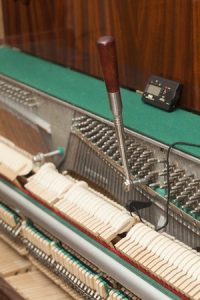Regular maintenance of your piano leads to proper tuning stability. When you’ve invested your time and money into a piano, you want to ensure it sounds its best. However, missed tuning sessions and a lack of upkeep can lead to lingering problems with pitch down the road.
Your piano creates optimum sound when it is tuned to the international pitch standard: A-440 (A above middle C vibrates at 440 cycles per second). This pitch provides peak power and tonal range and means your piano will match the pitch of other instruments. When your piano varies from A-440, more frequent pitch adjustments are required to return your piano to a state of tuning stability and to keep the strings and structure in equilibrium.
Piano strings change pitch due to the initial stretching and settling of strings when the piano is new and soundboard movement due to variations in humidity. With new pianos, the pitch drops quickly over the first few years as the strings stretch and the wood parts settle. The string tension and piano structure can reach a stable equilibrium if maintained at the proper pitch (A-440) during this period.
The piano’s main acoustical structure, the soundboard, is made of wood, which reacts constantly to climate changes. High humidity causes the soundboard to swell, stretching the piano strings to a higher pitch, while lower humidity can flatten the soundboard, lowering tension on the strings and causing the pitch to drop.
According to the Piano Technicians Guild, most piano manufacturers recommend three to four tunings the first year and at least two per year after that. If your piano has gone without tuning for years, it is likely its pitch has dropped way below A-440. This could mean that you need to try the process of pitch raising in order to restore your piano to the proper tone.
 Pitch Raising
Pitch Raising
A pitch raise is a special tuning procedure designed to leave the piano approximately in tune. During pitch raising, all of the piano strings are raised to their correct average tension levels. When all of the strings are so close to their proper tension that only small further changes are needed during tuning, then your piano can be tuned accurately.
If you do not conduct the process of pitch raising, tremendous additional tension is added to your piano’s structure when you tighten each string during a tuning. As each string is tightened, the additional load causes the pitch of the previously adjusted strings to change, making it impossible to make a substantial change in pitch and end up with accurate tuning in one step.
When you use pitch raising, however, the small changes required after raising each string to its average tension will not affect the tuning of the other strings, allowing you to correctly tune your piano.
The size and quality of the piano, as well as how accurate the final tuning must be, determines whether a pitch raise is necessary. When your piano’s pitch is noticeably different from that of other standard pitched instruments, it is time for a pitch correction procedure before tuning.
Pitch raises take about as much time as a tuning, depending on the severity of the correction required, and extreme pitch changes may require two or more separate pitch adjustments to correct. Keeping up with your regular maintenance, however, is still the best way to avoid needing multiple tuning sessions and pitch raises. Remember, the better care you take of your piano, the fewer adjustments it will require in the future!
Whether your piano is just a bit flat or in dire need of retuning, East Coast Piano Rebuilding can help. Contact us to discuss your needs and to schedule an appointment today!

Leave a Reply